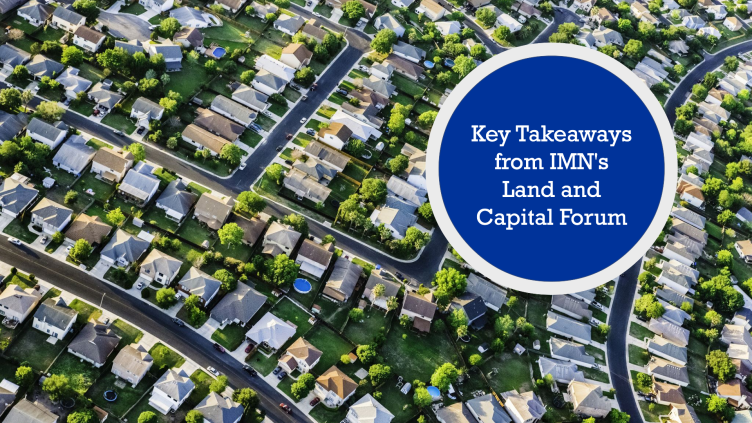Takeaways from IMN's Land and Capital Forum
Investor-Heavy Attendee List: Information Management Network (IMN)'s Land and Capital Forum was well attended last week as industry peers joined to hear about housing market updates, capital solutions, and M&A trends. We always find the mix of attendees at IMN to be interesting and indicative of the market overall. This time, the heavy weighting of investors underscores that the builders are thriving – generating good margins and returns, which in turn is attracting a lot of new capital providers to the space. Traditional lenders are scarce, especially for development assets, with land banking filling the void.
Incentives Persist Amid Growing Inventory: Per John Burns Research and Consulting, public builders now account for 47% of all new home sales and are purchasing 60% of available lots, solidifying their dominance in the market. While JBREC forecasts existing home sales will rise 4% YoY in 2025, new home sales are projected to remain flat. With mortgage rates still hovering near 7% and resale home inventory surging 30% since January 2024, builders continue to offer incentives - averaging 6% nationally - to sustain absorption. As the spring selling season kicks off, several of the builders noted ‘green shoots’ in terms of increased traffic and order momentum. Almost all of the builders are leaning into land-light strategies, prioritizing deal flow over margin to keep their pipelines active, driving the need for more land bankers in the industry.
Land Banking Momentum Continues: Both large and small homebuilders are attracting more capital for land banking. Public builders continue paying a premium for finished lots while avoiding entitlement risk, shifting the burden to developers. Land banking rates are averaging 10-14%, coming down slightly over the past year, with A&D capital viewed as an attractive risk-adjusted strategy for private equity. To become more efficient with land banking, builders benefit from establishing deeper relationships with a few partners, versus jumping between different providers on a deal-by-deal basis.
A Wave of Consolidation: Public homebuilders accounted for over 60% of all M&A activity in 2024, and consolidation is expected to continue as land acquisition becomes increasingly challenging for private builders. Secondary markets are gaining popularity, and private builders are commanding a premium due to public builders’ growing need for land and local market expertise. Sellers’ motivations vary from seeking stronger capital partners, to personal factors such as retirement or quality of life choices. When it comes to executing a deal, preparedness is key; invest in the process upfront and trust your advisors. Japanese buyers continue prioritizing long-term stability, favoring independent operators within their acquisitions. While they have yet to introduce Japanese technologies into their acquired builders, there is an expectation that gradual adoption will occur in the future.
For-Sale vs. For-Rent: The Housing Market's Next Play: The single-family rental (SFR) and build-to-rent (BTR) sectors remain active, though making deals pencil continues to be a challenge. While significant capital has been raised, deployment has been slow over the past two years, leaving substantial funds yet to be allocated. The shortage of attainable housing prevails, and the affordability gap between renting and buying has never been wider. With ample undeployed capital in the SFR space, future opportunities remain on the horizon. We continue to see our private builder clients embrace and benefit from high return BTR opportunities in the southeast.

